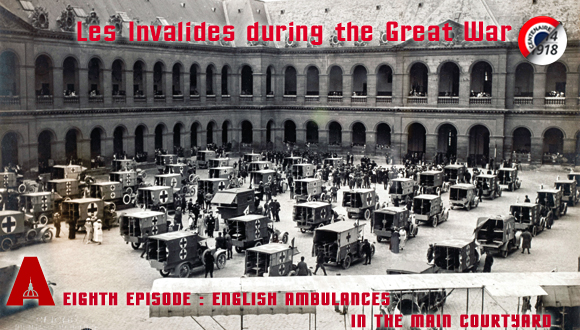On 20 July 1915, in the main courtyard of the Hôtel des Invalides, Great Britain offered 90 motor ambulances to France.
The President of the French Republic, Raymond Poincaré (1860-1934) went in person to pay tribute to the British ally, whose role on the western front is growing. A red cross on a white background adorning the sides of the vehicles could be distinctly seen. After the Red Cross was founded in 1863 by the Swiss Henry Dunant, the decree of 14 July 1865 stipulated that all hospitals and ambulances would henceforth be identifiable by a white flag with a red cross.
Medical vehicles
 The motor ambulances were in fact standard vehicles superficially adapted. The vehicle had to be very light to be able to get to the Aid posts travelling on roads often full of potholes and mud. At the beginning of the war, to lighten these medical vehicles, simple canvass was used to make the compartment for the wounded, in the same way as for goods. This system was uncomfortable and was not sufficient to protect the wounded from the weather during the journeys.
The motor ambulances were in fact standard vehicles superficially adapted. The vehicle had to be very light to be able to get to the Aid posts travelling on roads often full of potholes and mud. At the beginning of the war, to lighten these medical vehicles, simple canvass was used to make the compartment for the wounded, in the same way as for goods. This system was uncomfortable and was not sufficient to protect the wounded from the weather during the journeys.
As soon as possible, the canvas was replaced by a wooden compartment, to which a heating system using the exhaust gas was added. Some vans could carry five wounded on stretchers or eight seated, or again two lying down and four seated. The medical vehicles had inflatable tyres which cushioned the jolting while the trucks had far harder solid wheels.



Ajouter un commentaire